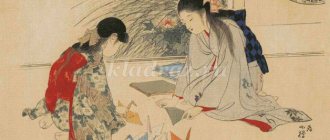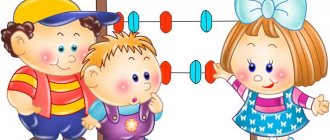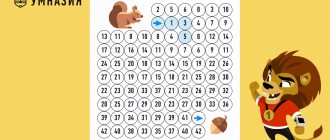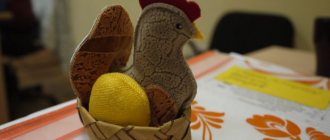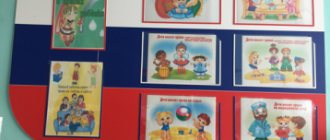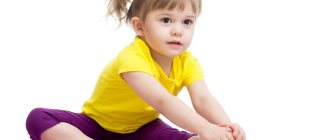Summary of OOD on cognitive development in the senior group of kindergarten
Summary of OOD on cognitive development in the senior group “Visiting Pochemuchka. Why does a hare have big ears... and what do they look like?
Integration of educational areas: “Speech development”, “Physical development”, “Social and communicative development”, “Artistic and aesthetic development”
Goal: - consolidate and expand children's knowledge about wild and domestic animals using the example of hares. Objectives: Educational:
- increase children’s speech activity;
enrich vocabulary; — clarify children’s understanding of the inhabitants of the forest; Developmental:
- develop children's attention, memory, logical thinking, observation;
- develop imagination and creativity. Educational:
- cultivate cognitive interest, respect for nature;
Methods and techniques: 1. Practical (making a picture from a puzzle, physical education); 2. Visual (demonstration of paintings, illustrations, presentations); 3. Verbal (stories, conversations, riddles). Preliminary work: Examination of illustrations depicting a forest, forest animals; reading the fairy tale “The Owl” by V. Bianchi; game based on a fairy tale; reading the works of E. Charushin “Hare”, “Fox”, “Wolf”. Reading the story “Hares” by L. Tolstoy. Materials and equipment: computer, projector, screen, paintings depicting a hare and domestic rabbits, a “magic” suitcase;
color pictures depicting wild animals, presentation “Why does a hare have long ears?” Vocabulary work: herbivore (herbivore), varied colors, adapted, lop-eared, sighted, mouthpiece, upright. Course of the lesson
1. Open entrance to the activity. Game motivation. Psychological attitude “Chain of Friendship” Children stand in a circle. Educator: (addresses the children) “Rub your palms, feel the warmth! Imagine that there is a small ball between your palms, let’s roll it! Now let’s share the warmth with each other: extend your palms to your neighbors! We have created a “chain of friendship”! Let’s smile and wish each other good luck!” 2. Introductory and organizational. Introductory conversation. Educator: Children, today our beloved Pochemuchka is visiting us. You know he loves to ask questions. And for correct answers he gives something. We all love gifts, so we will try to answer all his questions. (Pochemuchka enters. He has a suitcase in his hands.) 3. Motivation for activity. Creating a problematic situation, Pochemuchka: Hello, guys! Today I brought you a gift. This is a picture from a puzzle. But I will give it to you for the correct answers to my questions. For each correct answer you get one piece of the picture (1 puzzle). Are you all ready? Begin! 4. Explaining something new or expanding existing knowledge. Activation of independent thinking. Question: Guess who we're talking about: What kind of forest animal is it? Stood up like a post under a pine tree And stands among the grass - Ears larger than head. (Hare) Question: Write a story about a hare, completing the sentences. - The hare lives in the forest in ... (hole). - In summer the hare is .... (gray), and in winter .... (white). - The hare has long .... (ears). - Round... (head). - The front legs are shorter than .... (hind) - The hind legs are adapted for .... (jumping) - The tail is .... (small). - Up the mountain the hare ..... (runs), and from the mountain .... (somersaults). — The hare has a warm, light…..(fur coat). - The hare is afraid of... (fox, wolf, dog, people). — The hare loves to eat...(cabbage, carrots, turnips, grass, tree bark). - The hare quickly .... (runs), deftly ..... (jumps), but does not know how ..... (swim and climb trees). — A hare gives birth to ... (babies) in the summer. Question: Hares are herbivores. What does it mean? Children: Hares eat only plant foods: leaves, stems, roots, bark of young trees, fruits. They also eat mushrooms, but their favorite delicacy is aspen bark. For hares it is sweeter than sugar. Where there is an aspen tree fallen by the wind, the hares will gnaw the bark clean. The teeth of hares are suitable for this. Question: What can you say about cleft teeth? Children: The hare's teeth are large and flat - for feeding, not for attacking. Question: What is a hare usually called in fairy tales? Children: Cowardly bunny. Educator: I immediately want to justify the hares. Everyone thinks they are cowards. But this is not so. A ten-day-old hare fights off a magpie or crow by standing on its hind legs, waving its front legs and screaming loudly to intimidate. In the same way, their mother protects them from feathered enemies. And if the enemy attacks from the air, the hare falls onto her back and tries to rip open the attacker’s belly with her hind legs. The fox and marten are distracted from the hares by running around and firmly beating their feet on the ground. Happens and dies saving children. So, it’s a shame for the hares, they were unfairly classed as cowards. And the fact that they, having heard a rustle, take off from their place and run away is not cowardice, but animal wisdom: it is stupid to stand still waiting to be eaten. There is a Russian proverb about this: “The hare is not a coward, he takes care of himself.” 5. Dynamic pause. Gaming techniques. Finger gymnastics “Bunny” Look at that finger! Jumps deftly like a bunny. On a log and on a stump Jump and jump and jump and jump! (Children clench their hands into fists, stretching out two fingers and bending them. Then they make jumping movements with their hands.) Physical exercise: The bunny went out for a walk. The wind began to subside (walking in place)
The little bunny was tired.
He wants to hide in the bushes (squat)
So he gallops down the slope, runs into the green forest and rushes between the trunks, among the grass, flowers, bushes.
(jumping in place)
The bunny froze in the middle of the grass, And now we will freeze too!
(children sit down in their places) Question: He lives in a barn, in a cage, gnawing on sweet carrots. Oh, and sharp teeth, He is always in a fluffy fur coat, Lop-eared, tail like a zero. Everyone recognized him... Children: Rabbit. Question: Tell us about the rabbit (show picture) Children: Rabbits are a completely different animal - a domestic one. They resemble a hare. The body is covered with fur. They have long ears, short tails, and move by jumping. They have very sharp and long front teeth. Educator: I'll help. Both rabbits and hares are herbivores. In addition to various plants, they like to gnaw bark from trees. Domestic rabbits have long lived near a man who bred many different breeds of rabbits. Domestic rabbits come in a variety of colors (gray, white, black) and do not change coat color in the winter like a hare. Question: Tell us what differences there are between hares and rabbits. Children: The hare is gray in summer and white in winter. He does not dig holes and cannot live in one place for a long time. Hares are larger and have longer legs and ears. Hares are born sighted and covered with fur. Rabbits have a variety of colors. The rabbit digs holes and constantly completes them. The ears and front legs are shorter than those of a hare. Rabbits are born naked and blind, and are cared for by their mother. Why: I have something else in my suitcase. This is a megaphone. Why does he need it? Answer the question first. Question: Why do the hare have big ears? Children: The hare has the best hearing. The hare presses down to the ground, raises its ears vertically and, remaining invisible, learns about everything that is happening far around. Educator: But if it rains, you have to fold your ears, bend them so that water does not get into them and so as not to get sick. So in the rain, he has to stick his head out to find out the situation, which is extremely dangerous for the hare’s life. The ears of a hare have another remarkable feature - they are a kind of refrigerator. In extreme heat, they save the hare from overheating - through the thin, large ears the hare loses a third of its heat, and it does not need to stick out its tongue, as a dog does. The ears have another purpose, which helps the hare get rid of excess heat in the body and prevent overheating during a long chase. And in winter, when it’s cold, he presses his ears to his back, in order, on the contrary, to prevent loss of heat. Question: What do a hare and a bullhorn have in common? Children: A hare's ears look like a megaphone. The larger the ears, the better you can hear. Educator: Long, so as not to interfere with running. The hare throws them back. Let's watch the presentation “Why do the hare have long ears?” Showing the presentation “Why does a hare have long ears?” Why: Guys, I liked your interesting stories. We learned a lot of new and interesting things. I say thank you, goodbye. See you again! 6. Open withdrawal from activity. Discussion of results Educator: - Children, what did you like about the lesson? — What new and interesting things did you learn? - Guys, if you liked our lesson, then take a red ball, if you didn’t like it, then take a blue ball.
We recommend watching:
Summary of a lesson on cognitive development in the senior group. Our assistants Summary of OOD on constructive-model activities for children of the senior group Summary of a lesson in the senior group on the topic “Street of the native city” Summary of an integrated lesson on FEMP using Dienesh blocks for children of the senior group
Similar articles:
Lesson notes for the senior group of kindergarten. Kingdom of Three Minerals
